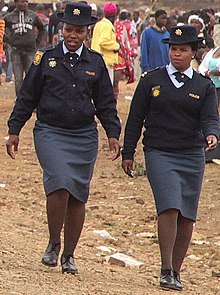International Association of Women Police

The International Association of Women Police (IAWP) is a global organization for women in criminal justice professions. Its mission is to "strengthen, unite and raise the profile of women in criminal justice internationally."[1]
Mission and Vision
According to the IAWP website, its mission, as stated in Article III, is to “strengthen, unite and raise the profile of women in criminal justice internationally”. Its vision is to ensure that “women’s lives [are] free from discrimination, valued for their contribution, and treated with respect and dignity. To contribute by being an example of excellence in securing a safe, harmonious workplace and society as partners in safety in the criminal justice system”. These core beliefs and objectives encompass the main message of the International Association of Women Police, and focus on standing up for the
History
The International Policewomen's Association was founded in 1915.
The Records of the International Association of Women Police are housed in the Lloyd Sealy Library Special Collections, John Jay College of Criminal Justice.[2][4]
Causes for Formation
As Stated in its Mission and Vision Statements, The International Association of Women Police came to be in order to fight against the
Harassment
The IAWP promotes the idea that female officers should not live in fear of
Discrimination
One of the main goals that the IAWP prides itself on is the abolishment of
Limited Job Opportunities
The IAWP prides itself on equality, and ensuring that women are presented equal opportunities in their
Equal Treatment
All across the

Prostitution Stings
Women
Various Stresses on the Force
The
Benefits Resulting From Women Police Officers
In recent years, women on the
Women Sheriffs and Police Chiefs
The IAWP's main goal is to empower women all across the world. One way women are able to do this is by working their way up to important roles on the police force such as
In Recent Years
In the organization's recent years, the number of women joining the IAWP has grown, and has not just been limited to women. Men that support the rights of women on the
Programs
The IAWP holds annual training conferences in major international cities, featuring invited speakers and exhibitors.[17]
The association offers an international scholarship under the IAWP Scholarship Program. An officer outside of the United States is selected to attend the Annual Training Conference at no expense to the Officer or her police organization. The IAWP also offers prestigious international awards in policing under the IAWP Awards Program. Nominations for each of the categories are solicited and awarded annually on an international basis. The International Association of Women Police is the only non-profit organization to offer international recognition for women in the law enforcement professions.
Regions and Areas Covered
The IAWP has a total of 26 regions where there are coordinators for people to contact. Within each region there is at least one coordinator's email linked onto the official IAWP website. There are coordinators in various states of the US, and all throughout Europe, Africa, and the Caribbean. To find a coordinator closest to any region/location an individual may find thelist on the IAWP official website.[18]
See also
Publications
- The Policewomen's Bulletin (1962–1974)
- The IAWP Bulletin (1966–1997)
- PoliceWoman (c. 1970 – 1987)
- WomenPolice (1988–present)
References
- ^ "About IAWP". International Association of Women Police. Archived from the original on 22 March 2013. Retrieved 5 March 2013.
- ^ a b c "Records of the International Association of Women Police Finding Aid". Lloyd Sealy Library Special Collections, John Jay College of Criminal Justice. Retrieved 5 March 2013.
- ^ "Brief History". International Association of Women Police. Retrieved 5 March 2013.
- ^ "Manuscript Collections". Lloyd Sealy Library Special Collections at John Jay College of Criminal Justice. Retrieved 5 March 2013.
- S2CID 143968570.
- .
- ^ a b c Wells, Alt, Sandra, Betty (2005). Police Women: Life With the Badge. Westport, CT: Praeger.
{{cite book}}: CS1 maint: multiple names: authors list (link) - S2CID 154436001.)
{{cite journal}}: CS1 maint: multiple names: authors list (link - ^ "File:Police officers of Poland (3).JPG". 2008-01-13. Retrieved 24 November 2013.
- S2CID 144156710.)
{{cite journal}}: CS1 maint: multiple names: authors list (link - ^ Johnson, Leanor B (1991). "Job Strain among Police Officers: Gender Comparisons". Police Studies: The International Review of Police Development.
- S2CID 145400449.
- ^ Gray, Madison (30 September 2013). "How to Curb Police Corruption: Hire More Female Cops". TIME Magazine.
- S2CID 145509506.)
{{cite journal}}: CS1 maint: multiple names: authors list (link - ^ Schulz, Dorothy M. (2004). Breaking the Brass Ceiling: Women Police Chiefs and Their Paths to the Top. Westport, CT: Praeger.
- ^ "IAWP A Brief History of the Organization from 1915 to Present".
{{cite web}}: Missing or empty|url=(help) - ^ "Events". International Association of Women Police. Retrieved 5 March 2013.
- ^ "IAWP Regional Coordinators".
